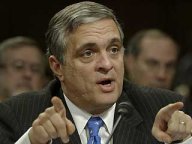The Global Con
What's the Blueprint? The Blueprint is a strategic plan to redesign life in the United States. You can get hints of it in this plan posted on the House of Representatives website:
Economic Stimulus and Recovery Plan
Assuming they would admit it, the proponents of the plan would say that they are building a 21st Century technology-driven country but what the Blueprint actually is - is a strategic plan for controlling our resources, political system and the people. The technology is not for your benefit. It's to control you. It's the final phase of the post World War II Marshall Plan - implementing the Morgenthau Plan in the United States.
It came to me when I was refreshing my memory on a story I wrote about regionalism and Agenda 21 in the Boise (Idaho) metropolitan area. I was going to turn the timeline into an actual story because it is one of the most important I've done not only for understanding the means by which our local officials were drawn into the Global Con but also who is behind the Con and the critical elements of the Blueprint. One of the critical pieces of information that I see didn't make it into the timeline but that should have been included was the first international conference of Mayors that was held in Lyon France in April, 2000. The following is an excerpt about the conference:
Lyon, France: Webb Opens First Transatlantic Summit of Mayors
"The Twenty-First Century will be the Century of Cities," Conference President Emphasizes"If the nineteenth century was the century of empires and the twentieth century the century of nation states, then the twenty-first century will be the century of cities," said Conference President and Denver Mayor Wellington E. Webb, opening the historic first Transatlantic Summit of Mayors in Lyon, France, April 6-8.
....
New Orleans Mayor Marc Morial observed, "You can't be a mayor today without having your own foreign policy. Mayors have to be more in tune with international political events than ever before."
Mayor Morial quoted the late Speaker of the U. S. House of Representatives, Tip O'Neill, who said, "All politics is local." "We need to revise that for the twenty-first century," Mayor Morial said, "to say that 'All politics will be global.'"
Host Mayor Raymond Barre of Lyon noted the unavoidable openness of cities to the exterior Š "the internationalization of cities is a reality." But he argued that global decentralization should not lead to uniformization of cities. "Cities need to safeguard their historical tradition," the characteristics that make them unique, he emphasized.
Mayor Coles urged mayors to understand our own strengths, regionally, nationally and internationally. "We must be engaged in regional strategies of smart growth and sustainability," he said. Globalization means that, "Mayors and cities may be more relevant than ever before. Let me recommend that in our next meetings that we share best practices regionally, nationally, and internationally."
The connection is made with this timeline entry in 1996:
Planting the Seed for Regionalism - Christine Saum, Executive Director of the Mayor’s Institute and Dena Belzer of Strategic Economics of Berkeley California suggest to Brent Coles that he organize a forum for Treasure Valley mayors to discuss regionalism.
not in the content itself, but with the Mayor's Institute on City Design:
The Mayors' Institute on City Design (MICD) is a partnership program of the National Endowment for the Arts, the American Architectural Foundation, and the United States Conference of Mayors. Since 1986, the Mayors' Institute has helped transform communities through design by preparing mayors to be the chief urban designers of their cities.

Origins of Polish MICD
MICD is a joint program of the U.S. Conference of Mayors, the National Endowment for the Arts and the American Architectural Foundation that educates city leaders on design policies and techniques. The program was founded in part by Riley in 1986. When Riley traveled with a previous Conference of Mayors delegation to Poland, he met with the City Architect of Warsaw and discussed the possibility of bringing Polish and American mayors together to share examples of good urban design projects and methods. Riley observed that Polish leaders are relatively new to capitalism and are seeking advice on how to guide urban development.
The delegation of U.S. mayors and architects traveled to Krakow to study the architectural design of a city that, unlike Warsaw, was largely intact through and after World War II. An outstanding local architect, Elzbieta Myczka, accompanied the group on a tour of Krakow, ending in the Main Market Square of the city. This square is the largest medieval town square in Poland and reputedly in all of Europe. “It is considered to be one of the finest urban designs of its kind,” according to the guidebook Lonely Planet, Poland, 2005 edition.
The delegation also visited the Auschwitz-Birkenau Memorial and Museum about an hour’s drive from Krakow. The camp began its operation on June 14, 1940, when the first transport of Polish political prisoners arrived. Over the following years, the camp was expanded. Jews, Poles, Soviet prisoners of war, gypsies, Catholic priests and others were brought to the camp.
In 1942, the camp became in the site of the greatest mass murder in the history of humanity. The number of victims of Auschwitz in the years 1940-1945 is estimated at between 1,100,000 and 1,500,000 people. The site was added to the UNESCO World Heritage List in 1970.
And this one -
Communities by smart design“Gee, I wish my colleagues back home could see this,” Mayor Joseph P. Riley Jr. of Charleston, S.C., recalls thinking as he admired the handsome old urban forms and new design initiatives of European cities on a 1984 trip organized by the German Marshall Fund of the United States.
So Riley, now acknowledged as the dean of major American city mayors -- he's served continuously since 1975 -- is determined to do something about it. Noting his belief that a mayor, through decisions he makes, is “the chief urban designer” of his city, Riley urged creation of what became the Mayors’ Institute on City Design, sponsored by the National Endowment for the Arts (NEA).
The Marshall Plan - Bureau of Labor Statistics (BLS) Contributions
The Marshall Plan was named for then Secretary of State George C. Marshall, who, on June 5, 1947, proposed his solution to war-devastated Europe. The proposal was enacted into law in April 1948 as the European Recovery Program, which created an Economic Cooperation Administration Agency to organize and administer the program.
The Marshall Plan at 60: The General’s Successful War On Poverty
Apart from its historical importance, the Marshall Plan experience offers valuable lessons that have relevance today. It represented a complete reversal of the preceding Morgenthau Plan, named after Treasury Secretary Henry Morgenthau Jr. In his 1945 book, Germany is Our Problem, Morgenthau promoted a de-industrialization plan, “converting Germany into a country principally agricultural and pastoral” to make sure it could never again go to war.
By late 1946, however, economic hardship and unemployment in Germany were worrying the United States, and former President Herbert Hoover was sent there on a fact-finding mission. Hoover’s third report of 18 March 1947 noted: “There is the illusion that the New Germany left after the annexations can be reduced to a ‘pastoral state’. It cannot be done unless we exterminate or move 25,000,000 people out of it.” Hoover well understood that an agricultural economy would be able to sustain a much smaller population than an industrialized nation.
The Morgenthau Plan described as a "Pastoral State" hides sheer evil behind Morgenthau's idea as Hoover's report on the impact on the population indicates. As I've said before, the ideas of history repeat but the implementation of those ideas vary with the times. The plan for 21st Century America, the 'New Economy', the carbon tax, windmills and solar panels for energy, rural cleansing, elimination of private property through federal management schemes and transit-oriented city design are all modern implementations of the Morgenthau Plan in the United States. And like the post World War II Morgenthau Plan, it won't support the population of the United States.
- September 1, 1968 - Mohamed Atta, born in Kafr el-Sheikh, Egypt (Legat Cairo)
- 1985 - 1990, Atta was a student at Cairo University
- January 1990 - As a senior at Cairo University, Atta enrolled in the Architectural Engineering Department.
- July 1990 - Atta graduated from Cairo University with a bachelor degree in architectural engineering
- Summer 1990 - Atta attended an intensive German language program at the Goethe Institute in Cairo
- October 1, 1990 - February 1, 1991 - Atta was employed at the Urban Development Center in Cairo, where he worked on architectural, planning, and building design.
- May 25, 1992 - Atta obtains an Egyptian passport

"He started as an aide to a lobbying group for solar power. He then worked for a long time on Capitol Hill, mainly for moderate Democrats. The most important mentor in his career was David Boren, a conservative Democrat from Oklahoma who chaired the Senate Intelligence Committee during a period where Tenet was his chief staffer. It was through Boren's mentorship that Tenet moved from the Senate to the Clinton National Security Council [NSC], where he was in charge of intelligence, budgeting and decision-making at a level that put him right at the heart of the bureaucratic process that is the intelligence community in D.C. For several years, completely out of the limelight, he worked at the NSC at the heart of this culture.

And I almost forgot what set me off this morning. The Washington Post has a series of articles on the nature (pun intended) of the economic stimulus plans:
Vicky Davis
1/11/2009